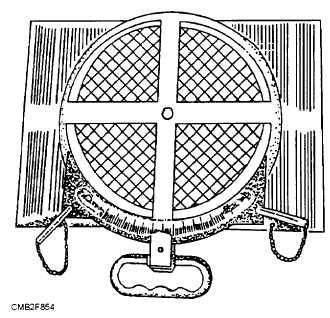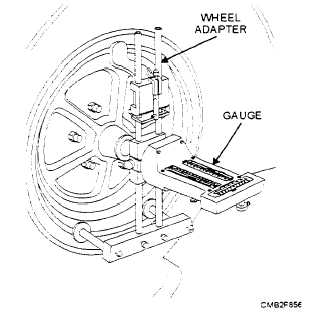the least complicated of all alignment equipment and illustrate the fundamentals for wheel alignment easily.
In larger shore facilities these basic types of equipment are normally replaced with a large alignment rack. The alignment rack consists of ramps, turning radius gauges. and specialized equipment for measuring alignment angles.
Turning Radius Gauges
Turning radius gauges (fig. 8-54) measure how many degrees the front wheels are turned right or left. They are used when measuring caster, camber, and toe-out on turns.
The portable type turning radius gauges are the most common in the Naval Construction Force (NCF). However, they are also mounted on alignment racks as integral units.
The front wheels of the vehicle are centered on the turning radius gauges. With the front wheels centered, the locking pins are pulled out which allows the gauge and tire to turn together. The pointer on the gauge will indicate how many degrees the wheels have been turned.
The procedures for checking toe-out on turns using turning radius gauges are as follows:
Center the front tiresofthe vehicle on the turning radius gauges and remove the locking pins.
Turn one of the front wheels until the gauge reads 20 degrees.

Figure 8-54. - Turning radius gauge, portable type.
Then read the number ofdegrees showing on the other gauge. Check toe-out on turns on both right and left sides.
Note the readings. If not within manufacturer specifications, check for bent or damaged components.
Caster-Camber Gauge
The caster-camber gauge is used with the turning radius gauge to measure caster and camber in degrees. The caster-camber gauge either fits on the hub magnetically (fig. 8-55) or may be mounted on the wheel with an adapter (fig. 8-56). Caster and camber are adjusted together since one affects the other.

Figure 8-55. - Magnetic Caster-Camber Gauge.

Figure 8-56. - Caster-Camber Gauge mounted on a wheel adapter.
Continue Reading